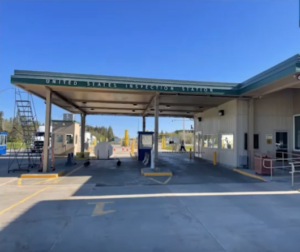
Photo courtesy of the U.S. General Services Administration.
There are 167 land ports of entry (LPOE) in the U.S. that provide border crossing security for both people and trade. Those crossings generate billions of dollars in goods and services for the country. Every year an average of 160,000 motorists, 72,000 pedestrians, and 34,000 commercial trucks pass through those ports of entry. That’s the good news…but the bad news is that the crossings are extremely old, outdated, and inefficient. Some are unsafe and entirely too congested. That is all about to change!
At least 26 major construction projects related to land ports of entry will launch soon. Funding for the work has been allocated through passage of the Bipartisan Infrastructure Law.
The congestion that exists at every land port adds another negative component to the country’s supply chain issues. Recent reports outline data showing that a 10-minute reduction in crossing time along the U.S.-Mexico border would generate at least an additional $312 million annually in commerce.
So, the federal government has allocated an investment of $3.4 billion to address this issue. The new funding will support large-scale efforts to construct, expand, repair, or alter land port crossings in 12 states. Another $330 million is available for modernization projects which will include leading edge technology.
Economic indicators suggest that the modernization efforts will produce 6,000 new jobs each year for the next 8 years and generate an additional $3.23 billion in labor income while adding $4.5 billion to the national gross domestic product (GDP).
At the third busiest crossing in California, a $103.4 million project will be launched to link a critical agricultural center in California to the Mexican state of Baja California. The crossing will be expanded and modernized for both pedestrian and vehicle capacity. Federal funding will cover construction of new inspection facilities which will include an administration building, canopied inspection areas, and expanded vehicle inspection lanes. Other project components include new technology, demolition work, and the construction of a new pedestrian processing facility.
In Douglas, Arizona, a $200 million project is currently in the design phase. An existing land port of entry that links Arizona to the Mexico border was originally built in 1933 and it is scheduled for a massive overhaul. The facility is so old that it is included on the National Register of Historic Places. It forces inbound and outbound trucks to negotiate the same undersized passageway for commercial vehicle inspections and that not only fosters congestion, but also creates significant safety hazards. The project will include construction of new facilities and technology.
Just 5 miles away, another $200 million project will be launched at a border crossing port. Architectural and engineering work has started but the construction must wait on project compliance related to the National Environment Policy Act (NEPA). This project will deliver a new, dedicated commercial land port of entry which will only be available for commercial crossings. It will relieve congestion and resolve several safety issues that have been noted during inspections of the other nearby border crossing.

Photo courtesy of the U.S. General Services Administration.
A $50 million project in Dunseith, North Dakota is targeted for a launch date of January 2023. A design-build construction project will modernize and expand the existing land port of entry. Work will include replacement of the main building and other expanded ancillary facilities. Other components include a rearranged staging area for commercial vehicles, a secondary inspection dock and facility, and new inspection lanes. Public areas will be enhanced, and parking will be improved while advanced technology is deployed.
The Highgate Springs LPOE in Vermont, one of the most active crossings at the U.S.-Canadian border, has been granted $170 million for a major modernization project. An environmental assessment is underway, and work will begin as soon as it is completed. This border crossing handles more than 475,000 private vehicles and 97,000 commercial trucks annually. The funding will enable construction of a new central processing facility to coincide with a new U.S.-Canada roadway which is also under construction. The new facility will include expanded inspection lanes with mandates for sustainability which will include features such as low carbon concrete standards and materials.
A $250 million allocation was awarded for modernization along with safety and security upgrades to the land port crossing in International Falls, Minnesota. Stakeholder engagement outreach has been completed and design and engineering work is now underway. This full-service crossing, located near an international bridge between the U.S. and Canada, is the state’s busiest port but it is extremely old and has been deemed functionally obsolete. A new facility that will be expanded and outfitted with state-of-the-art technology is planned. The modernization and expansion project will provide accelerated levels of cross-border trade and travel.
This type of federal funding will escalate construction projects immediately, but every effort will also require services that include engineering, technology, professional services, and an abundance of equipment.







